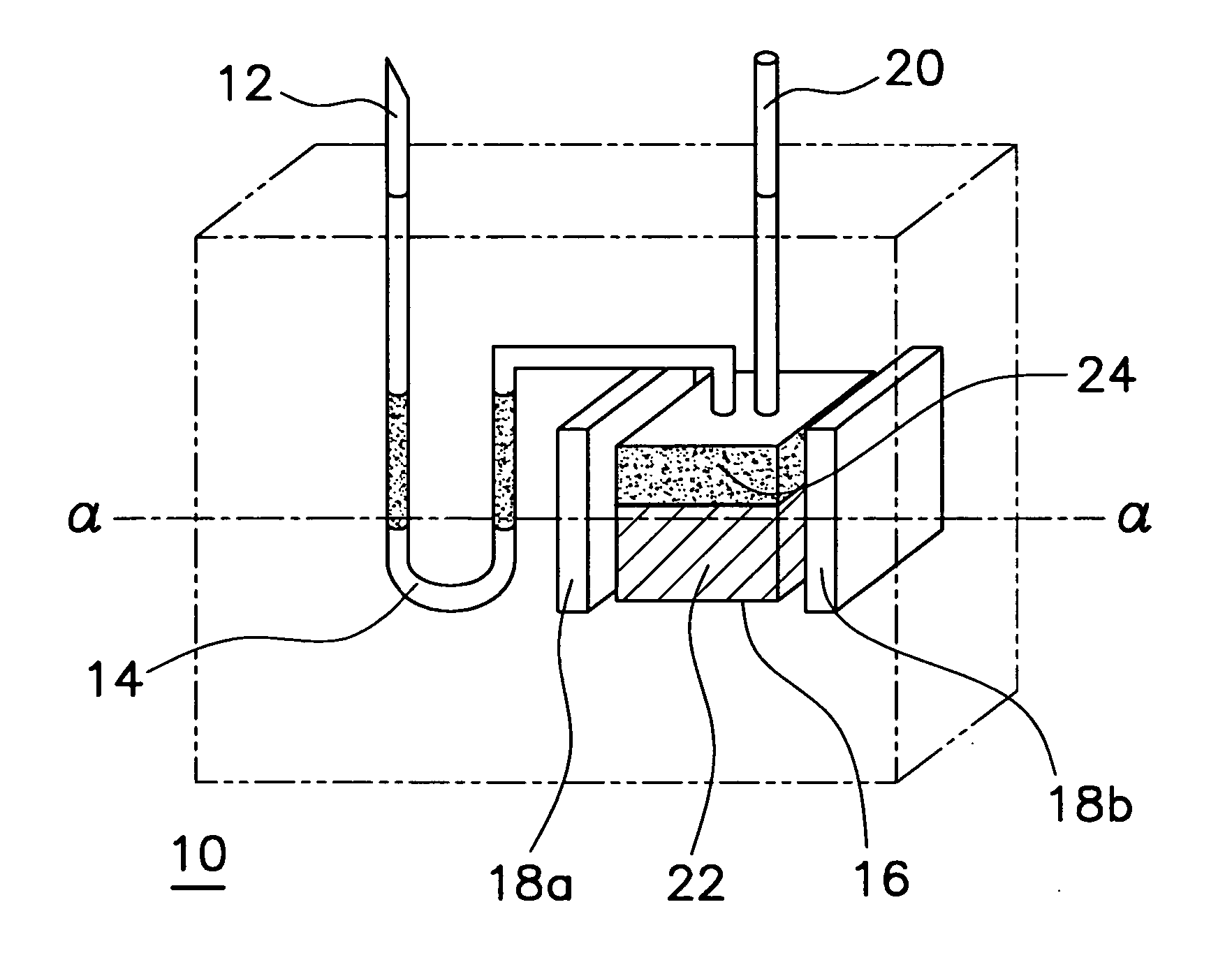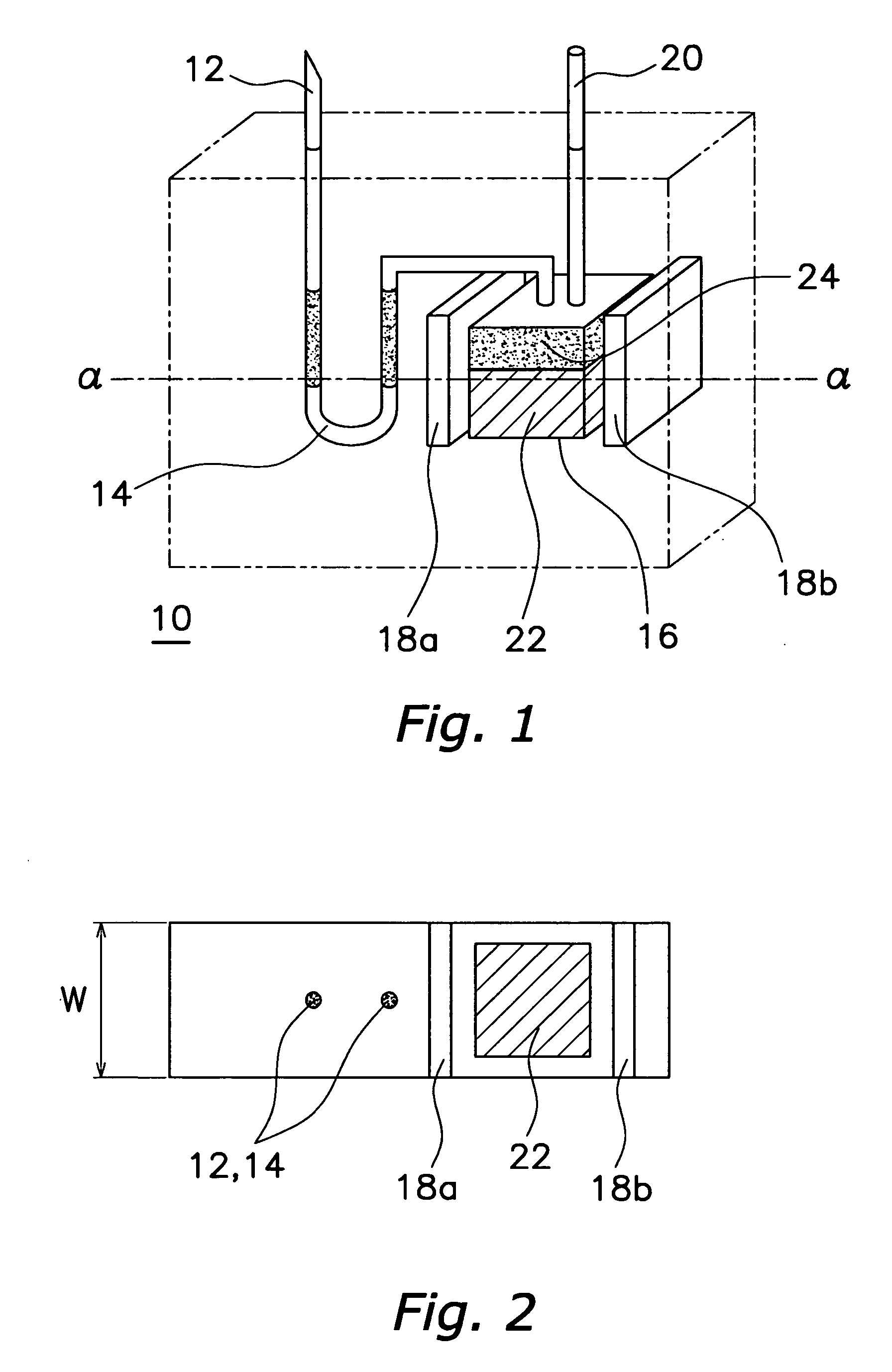Quantitative method and quantitative chip for target substance
a quantitative measurement and target substance technology, applied in the field of quantitative measurement methods and quantitative measurement chips for target substances, can solve the problems of mixing blood serum and reagents, large measurement devices for biochemical measurements in hospitals and blood measurement centers, and high cost, so as to achieve accurate collection, simplify and achieve accurate quantitative measurement of target substances
- Summary
- Abstract
- Description
- Claims
- Application Information
AI Technical Summary
Benefits of technology
Problems solved by technology
Method used
Image
Examples
embodiment
[0059]FIG. 1 is a structural diagram of the quantitative measurement chip according to an embodiment of the present invention, FIG. 2 is a plan view of the cross-section taken along line α-α in FIG. 1, FIG. 3(a) is an expanded diagram of a reaction cell, FIG. 3(b) is an expanded diagram of the reaction cell, photoemission hole, and photoreception hole, and FIG. 3(c) is a descriptive diagram showing the relationship between the planar direction of the photoemission hole and the planar direction of the photoreception hole to the planar direction of the contact interface. The structure of the quantitative measurement chip of the embodiment will be described below.
Structure
[0060] A quantitative measurement chip 10 is a transparent plastic PET substrate, and has an injection port 12 such as a blood sampling needle, an injection tube 14, a reaction cell 16, an photoemission hole 18a, an photoreception hole 18b, and a discharge port 20. The reaction cell 16 comprises a structure 22 made...
example 1
[0092] Using the aforementioned quantitative measurement chip 10 shown above, lactic dehydrogenase (LDH), a marker for improper liver function and myocardium health, was quantitatively measured as the target substance. Agarose was used for the structure 22. Furthermore, the mesh structure 22 which consists of agarose contained pyruvic acid and NADH (reduced nicotinamide adenine dinucleotide), which are reagents for detecting LDH. The method of preparing the structure 22 which contains a reagent including a base material and a buffer solution in the mesh will be described below.
Method of Preparing the Structure
[0093] Powdered agarose may have absorbed moisture, and was therefore dried for several minutes in a vacuum dryer. 50 mg of powdered agarose was weighed using a medicine spoon, tweezers, and an electronic balance, and then placed in a sample bottle. Later the temperature will be increased to approximately 90° C., so using a sample bottle which can withstand pressure is prefe...
example 2
[0100] A test was performed concerning the diffusion distance for the case where the target substance was made to contact with the structure 22 shown above, and the required length T of the structure 22 was determined. The length T is defined as the length of the structure 22 in the direction which intersects with the contact interface A between the structure 22 and the target substance.
[0101]FIG. 10 shows a reaction cell for measuring the diffusion distance. The reaction cell 16 has a 1 mm×12 mm photoemission hole 18a and an photoreception hole 18b. A structure 22 and a contact unit 24 are established in the reaction cell 16.1% Agarose was used for the structure 22. The dye (acid red) is injected into the contact unit 24 in the reaction cell 16, the reaction cell 16 is brought into contact with the structure 22 which consists of agarose.
[0102]FIG. 11 shows the relationship between the quantitative measurement time and the light absorbency for 0.4 mM, 0.8 mM, 1.0 mM, and 4.0 mM co...
PUM
| Property | Measurement | Unit |
|---|---|---|
| optical path length | aaaaa | aaaaa |
| optical path length | aaaaa | aaaaa |
| wavelength | aaaaa | aaaaa |
Abstract
Description
Claims
Application Information
 Login to View More
Login to View More - R&D
- Intellectual Property
- Life Sciences
- Materials
- Tech Scout
- Unparalleled Data Quality
- Higher Quality Content
- 60% Fewer Hallucinations
Browse by: Latest US Patents, China's latest patents, Technical Efficacy Thesaurus, Application Domain, Technology Topic, Popular Technical Reports.
© 2025 PatSnap. All rights reserved.Legal|Privacy policy|Modern Slavery Act Transparency Statement|Sitemap|About US| Contact US: help@patsnap.com



